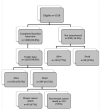Frailty and long-term mortality of older breast cancer patients: CALGB 369901 (Alliance)
- PMID: 28364214
- PMCID: PMC5479131
- DOI: 10.1007/s10549-017-4222-8
Frailty and long-term mortality of older breast cancer patients: CALGB 369901 (Alliance)
Abstract
Purpose: Breast cancer patients aged 65+ ("older") vary in frailty status. We tested whether a deficits accumulation frailty index predicted long-term mortality.
Methods: Older patients (n = 1280) with non-metastatic, invasive breast cancer were recruited from 78 Alliance sites from 2004 to 2011, with follow-up to 2015. Frailty categories (robust, pre-frail, and frail) were based on 35 baseline illness and function items. Cox proportional hazards and competing risk models were used to calculate all-cause and breast cancer-specific mortality for up to 7 years, respectively. Potential covariates included demographic, psychosocial, and clinical factors, diagnosis year, and care setting.
Results: Patients were 65-91 years old. Most (76.6%) were robust; 18.3% were pre-frail, and 5.1% frail. Robust patients tended to receive more chemotherapy ± hormonal therapy (vs. hormonal) than pre-frail or frail patients (45% vs. 37 and 36%, p = 0.06), and had the highest adherence to hormonal therapy. The adjusted hazard ratios for all-cause mortality (n = 209 deaths) were 1.7 (95% CI 1.2-2.4) and 2.4 (95% CI 1.5-4.0) for pre-frail and frail versus robust women, respectively, with an absolute mortality difference of 23.5%. The adjusted hazard of breast cancer death (n-99) was 3.1 (95% CI 1.6-5.8) times higher for frail versus robust patients (absolute difference of 14%). Treatment differences did not account for the relationships between frailty and mortality.
Conclusions: Most older breast cancer patients are robust and could consider chemotherapy where otherwise indicated. Patients who are frail or pre-frail have elevated long-term all-cause and breast cancer mortality. Frailty indices could be useful for treatment decision-making and care planning with older patients.
Trial registration: ClinicalTrials.gov NCT00068328.
Keywords: Breast cancer; Frailty; Mortality; Older; Survival.
Conflict of interest statement
Conflict of Interest Disclosures: Jeanne S. Mandelblatt, MD, MPH- None
Ling Cai, PhD - None
George Luta, PhD - None
Gretchen Kimmick, MD - Consultant to Genomic Health, AstraZeneca, Novartis, Pfizer
Jonathan Clapp, MS- None
Claudine Isaacs, MD - Honoraria from Genentech and Pfizer; Advisory board for Astra-Zeneca
Brandelyn Pitcher, MS- None
William Barry, PhD - None
Eric Winer, MD – None
Steve Sugarman – None
Clifford Hudis, MD - None
Hyman Muss, MD - None
Harvey J. Cohen, MD- None
Arti Hurria, MD- Consulting services for Boehringer Ingelheim, Carevive, Sanofi, GTx Inc, and Perian Biosciences and research funding from Novartis, Celegene, and GSK.
Figures



References
-
- Hurria A, Naylor M, Cohen HJ. Improving the quality of cancer care in an aging population: recommendations from an IOM report. JAMA. 2013;310(17):1795–1796. - PubMed
MeSH terms
Associated data
Grants and funding
- R01 AG019771/AG/NIA NIH HHS/United States
- U10 CA031946/CA/NCI NIH HHS/United States
- U10 CA033601/CA/NCI NIH HHS/United States
- UG1 CA189823/CA/NCI NIH HHS/United States
- U10 CA084131/CA/NCI NIH HHS/United States
- K05 CA096940/CA/NCI NIH HHS/United States
- R35 CA197289/CA/NCI NIH HHS/United States
- U10 CA047577/CA/NCI NIH HHS/United States
- U54 CA137788/CA/NCI NIH HHS/United States
- U10 CA032291/CA/NCI NIH HHS/United States
- R01 CA124924/CA/NCI NIH HHS/United States
- R01 CA127617/CA/NCI NIH HHS/United States
- U10 CA180821/CA/NCI NIH HHS/United States
- U10 CA077597/CA/NCI NIH HHS/United States
- U10 CA180791/CA/NCI NIH HHS/United States
- U10 CA180857/CA/NCI NIH HHS/United States
- U10 CA037447/CA/NCI NIH HHS/United States
- U54 CA132378/CA/NCI NIH HHS/United States
- P30 CA051008/CA/NCI NIH HHS/United States
- U10 CA047559/CA/NCI NIH HHS/United States
- R01 CA129769/CA/NCI NIH HHS/United States
- U10 CA077651/CA/NCI NIH HHS/United States
- U10 CA180867/CA/NCI NIH HHS/United States
- U10 CA180838/CA/NCI NIH HHS/United States
LinkOut - more resources
Full Text Sources
Other Literature Sources
Medical

